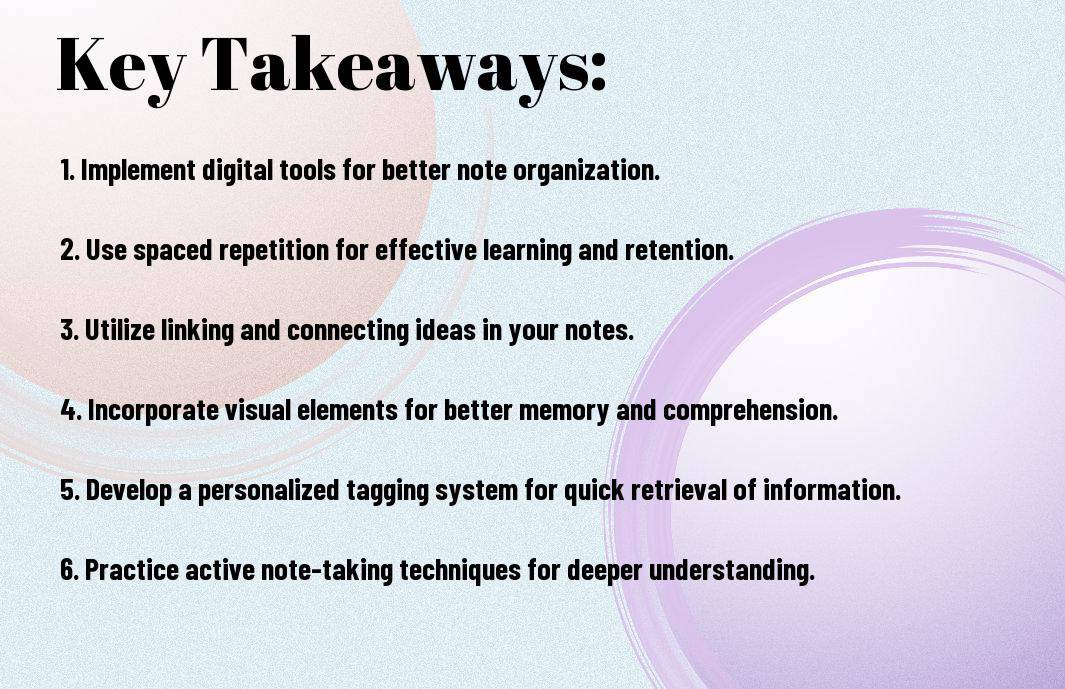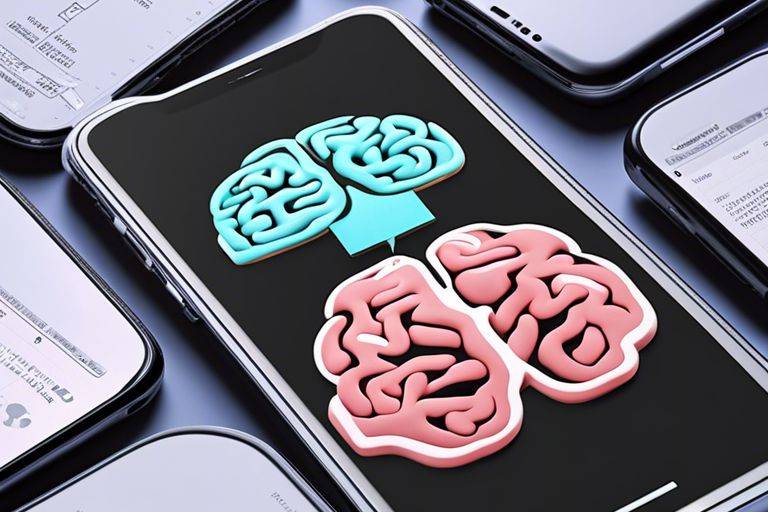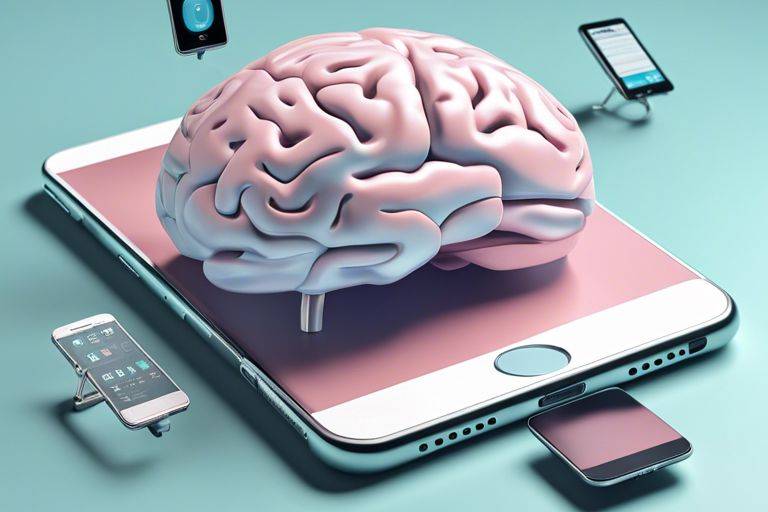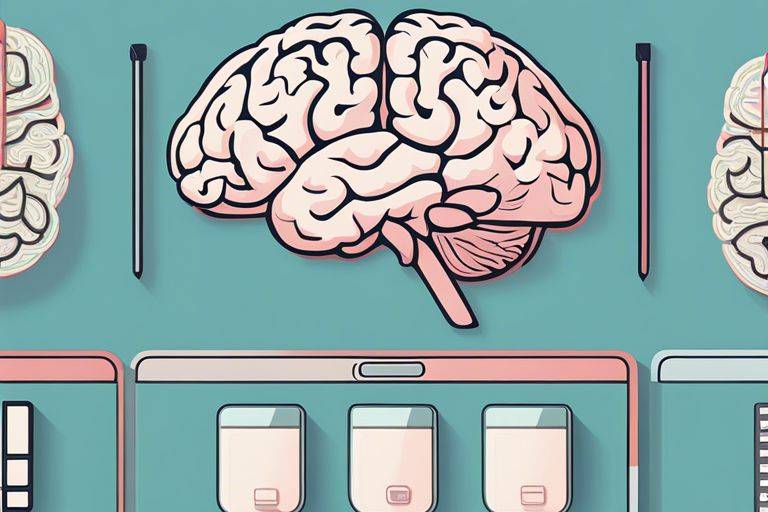You have the power to revolutionize the way you take notes and organize information by implementing advanced systems for your second brain. In this blog post, we will explore techniques and methods that can transform the way you learn, remember, and create. Dive into the world of efficient note-taking and discover a new way to optimize your cognitive abilities.
If you are ready to level up your note-taking game, Master the Art of Note-taking with Tiago Forte’s Second Brain Method is a must-read. Explore the innovative strategies that can enhance your productivity and unleash your full potential. Join us on this journey to transform your notes into a powerful tool for personal growth and success.
Key Takeaways:
- Implement an advanced note-taking system: Creating a second brain with advanced note-taking systems can help you organize and retain information effectively.
- Utilize tools like Roam Research and Notion: These tools provide features like bi-directional linking and databases to enhance your note-taking process.
- Focus on capturing ideas over complete thoughts: Quick, concise notes can help you capture ideas efficiently and build upon them later.
- Create a knowledge graph: Interlinking notes and ideas in a visual representation can help you see connections and patterns more easily.
- Regularly review and refine your notes: Schedule time to review and update your notes to ensure they remain accurate and useful.
- Use templates for consistency: Templates can streamline your note-taking process and help you maintain a consistent structure across your notes.
- Experiment and adapt your system: Don’t be afraid to try new methods or tools and make adjustments to your note-taking system based on what works best for you.

Laying the Groundwork for Your Second Brain
Little did you know that your note-taking system could be transformed into a powerful second brain – a digital repository where you can store, organize, and retrieve information effortlessly. But before exploring into the intricacies of advanced systems, it’s vital to lay the groundwork for your second brain.
Understanding Cognitive Load
Brain overload is a real phenomenon, and trying to cram endless bits of information into your memory can lead to cognitive overload. This is where your second brain comes in handy – by offloading the burden from your mind onto an external system, you free up mental capacity for deeper thinking and creativity. Understanding the concept of cognitive load is crucial in building a second brain that efficiently processes and stores information.
Principles of External Storage
For a second brain to be effective, it must adhere to the principles of external storage. By externalizing your thoughts, ideas, and data into a reliable system, you create a seamless workflow that enhances your productivity and knowledge retention. Organizing information in a structured manner and tagging it with relevant keywords are imperative principles to follow for optimal retrieval and utilization.
It is imperative to develop a system that suits your learning style and workflow. Whether you prefer digital tools or traditional pen and paper, the key is to establish a consistent method that aligns with your habits and preferences. By adhering to the principles of external storage, you can build a robust second brain that acts as an extension of your mind, efficiently managing and accessing a wealth of information.

Choosing the Right Tools for Your Second Brain
Many individuals today are looking to revolutionize their note-taking systems and create an advanced second brain to enhance their productivity and organization. Selecting the right tools is a critical step in this process to ensure that information is captured efficiently and effectively. There are various options available, from traditional pen and paper to digital note-taking apps and cloud-based solutions.
Digital Note-Taking Apps
The use of digital note-taking apps has grown significantly in recent years, offering users a wide range of features to organize and store their notes. Apps like Evernote, Notion, and OneNote provide users with the ability to create different types of notes, such as text, images, audio, and video. These apps also offer features like tagging, categorization, and search functionality, making it easy to retrieve information quickly.
Utilizing Cloud-Based Solutions
The advent of cloud-based solutions has further revolutionized note-taking, allowing users to access their notes from any device with an internet connection. Cloud-based platforms like Google Drive, Dropbox, and iCloud offer seamless synchronization across devices, ensuring that your notes are always up to date. Additionally, cloud storage provides a secure backup of your notes, protecting them from loss or damage.
To fully leverage cloud-based solutions for your second brain, it is vital to establish a consistent workflow for saving and organizing your notes. By creating a system that ensures all notes are properly categorized and tagged, you can maximize the efficiency and effectiveness of your second brain.
Capture Techniques – Never Lose a Thought
Despite our best intentions, our minds can be like leaky buckets when it comes to holding onto thoughts and ideas. And who hasn’t experienced the frustration of a brilliant notion slipping away because there wasn’t a system in place to capture it immediately? The key to preventing these valuable gems from disappearing into the void is establishing solid capture techniques. By honing these methods, you can ensure that no idea gets left behind.
Effective Methods for Capturing Information
Methods for capturing information are varied and can range from traditional pen and paper to digital tools that sync seamlessly across devices. The important thing is to choose a method that works best for you and that you can access quickly and consistently. Whether you prefer a trusty notebook and pen or a slick note-taking app like Evernote or Notion, the key is to have it on hand whenever inspiration strikes. Utilize voice memos on your phone, jot notes in a dedicated journal, or use specialized apps designed for capturing thoughts on the go – find what suits your style and stick with it.
Creating a Habit for Consistent Capture
The habit of consistent capture is where the magic happens. Set a reminder on your phone, make a commitment to yourself to jot down a certain number of thoughts every day, or incorporate capturing ideas into your daily routine. By making it a natural part of your day, you’ll find that capturing ideas becomes second nature. The key is consistency – don’t let a single valuable thought slip away because you were too busy or forgot to jot it down. Treat each idea as a precious seed that needs to be planted and nurtured to grow into something truly spectacular.
Organizing Your Second Brain for Maximum Efficiency
Not sure how to best organize your second brain for maximum efficiency? Check out 9 of the Best Note-Taking Apps for Building a Second Brain to get started on the right track.
Categorization Systems
Any effective note-taking system relies on a robust categorization system to help you quickly locate information when needed. Whether you choose to categorize by topic, project, or priority level, creating a clear structure will significantly enhance your productivity and organization.
Advanced Tagging and Indexing Strategies
Any advanced tagging and indexing strategies can take your second brain to the next level. By implementing a hierarchical tagging system, combining tags with metadata, or utilizing AI-powered tagging tools, you can streamline the process of retrieving information and connecting related concepts.
-
- Tag Hierarchies:
| Benefits: | Allows for nested categorization, offering a more granular way to organize notes. |
-
- AI-Powered Tagging:
| Benefits: | Automatically suggests tags based on content analysis, saving time and improving accuracy. |
Your Second Brain
Any efficient second brain system should prioritize consistency in categorization and tagging to avoid confusion or duplication of efforts. By establishing clear guidelines for organizing information and regularly reviewing and optimizing your system, you can ensure that your second brain remains a valuable tool for boosting your productivity and creativity.
Integration and Application – Making Knowledge Work for You
Once again, we explore into the crucial aspect of integrating and applying knowledge gained through meticulous note-taking. This step is where the magic happens as you bring together various pieces of information to create a comprehensive understanding and actively apply it to your projects, work, or daily life.
Linking Notes and Ideas
Making connections between your notes and ideas is crucial for creating a web of knowledge that is interconnected and easily accessible. By linking related notes and ideas, you establish a network that allows for seamless transitions between different topics. This practice not only enhances your understanding of complex subjects but also facilitates creative thinking and problem-solving.
Techniques for Reviewing and Synthesizing Information
Making time for regular review and synthesis of your notes is key to solidifying your understanding and retaining information in the long term. Techniques such as summarizing key points, creating mind maps, and linking new information to existing knowledge can aid in synthesizing information effectively. Additionally, reflecting on how the new knowledge fits into the bigger picture of your existing knowledge base can provide valuable insights and deepen your understanding.
Another crucial technique for reviewing and synthesizing information is the use of spaced repetition. This method involves reviewing information at increasing intervals over time, reinforcing your memory and ensuring long-term retention. By incorporating spaced repetition into your review process, you can optimize your learning and make the most of your notes.

Security and Maintenance of Your Second Brain
Protecting Your Digital Notes
The security of your digital notes is paramount to the integrity of your second brain. Encryption is a vital component in safeguarding your information from unauthorized access. Make sure to use a reliable password manager to generate and store complex passwords for your note-taking apps. Additionally, consider utilizing two-factor authentication whenever possible for an added layer of security.
Regular Maintenance Schedules and Data Hygiene
Your second brain requires regular maintenance to ensure optimal functioning and longevity. Regular backups of your notes are imperative to prevent data loss in case of technical failures or accidental deletions. Establish a routine to clean up obsolete or redundant information to keep your second brain organized and efficient.
Regular data hygiene practices involve reviewing and updating your notes, archiving information that is no longer relevant, and keeping your digital workspace clutter-free. Set aside dedicated time to declutter and organize your notes to maintain a streamlined and efficient second brain.
To wrap up
Drawing together all the advanced systems for your second brain discussed in this guide will undoubtedly revolutionize the way you take notes. By incorporating techniques such as the Zettelkasten method, spaced repetition, and visual mapping, you can elevate your note-taking process to a whole new level. These systems provide structure, organization, and efficiency that will help you better retain information, make connections between ideas, and unleash your creativity.
Embracing these advanced note-taking systems is a powerful way to supercharge your learning and productivity. By implementing these strategies into your daily routine, you can transform your notes into a dynamic second brain that serves as a valuable resource for your personal and professional growth. Revolutionize your notes today and unlock the full potential of your second brain!
FAQ
Q: What is the Second Brain concept?
A: The Second Brain is a system for organizing and storing information outside of your mind, making it easier to access and utilize when needed.
Q: Why should I revolutionize my notes with advanced systems?
A: Advanced note-taking systems can help you better organize, retain, and access information, leading to increased productivity and efficiency.
Q: What are some advanced systems for note-taking?
A: Some advanced note-taking systems include the Zettelkasten method, the Cornell method, and mind mapping techniques.
Q: How can I create an effective Second Brain system?
A: To create an effective Second Brain system, start by identifying your goals, organizing your information in a meaningful way, and regularly reviewing and updating your notes.
Q: What tools can I use to enhance my note-taking system?
A: Tools such as note-taking apps like Evernote or Notion, digital highlighters, and voice-to-text software can enhance your note-taking system and make it more efficient.
Q: How can I maintain consistency in my note-taking practices?
A: To maintain consistency, create a note-taking routine, establish a tagging system for your notes, and set aside regular time for organizing and reviewing your materials.
Q: What are the benefits of revolutionizing my notes with advanced systems?
A: Revolutionizing your notes with advanced systems can lead to improved information retention, enhanced creativity, better problem-solving skills, and increased overall knowledge management.
Dive Deeper: Further Explorations for Your Journey
The 10-Minute Rule – A Method to Overcome Procrastination by Starting Small
Learning to Say No – The Importance of Prioritizing Tasks and Commitments
SMART Goals – George T. Doran’s Method for Setting Clear and Achievable Goals
The 2 Minute Rule – David Allen’s (popularized) Trick to Overcome Procrastination and Start Tasks



